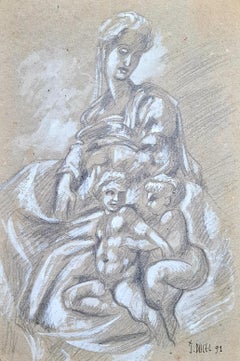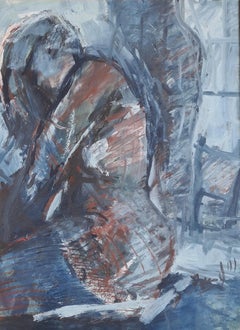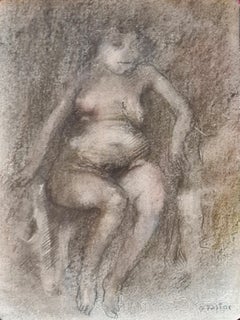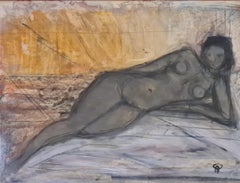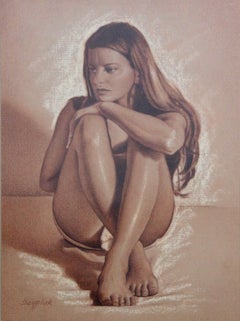La Galerie Cotignac Nude Drawings and Watercolors
to
4
9
5
6
3
4
1
3
1
Overall Height
to
Overall Width
to
5
8
6
4
3
3
2
2
1
9
1
8
7
3
3
3
Female Nude, Pastel and Chalk Study for a Sculpture
Located in Cotignac, FR
A chalk and crayon study for a scuplture by French female artist Marie-Josèphe Bourron. Presented in modern frame with mount under glass. Though not signed the drawing was acquired d...
Category
Late 20th Century Realist Nude Drawings and Watercolors
Materials
Paper, Chalk, Crayon, Pastel
Renaissance Style Drawing of The Medici Madonna and Cherubs
By Michelangelo
Located in Cotignac, FR
A pencil and watercolour drawing of a Madonna and cherubs inspired by the carvings of Michelangelo Buonarroti. Signed and dated bottom right.
An elegant and charming stylised drawin...
Category
Late 20th Century Renaissance Figurative Drawings and Watercolors
Materials
Crayon, Watercolor, Pencil
Odalisque, Watercolour of a Female Nude
Located in Cotignac, FR
Late 20th Century watercolour on paper of a naked female figure before an open window. Signed bottom right but as yet not deciphered. Presented in carved, white painted wood frame.
...
Category
Late 20th Century Modern Figurative Drawings and Watercolors
Materials
Paper, Watercolor, Gouache
Woman on a Bed
By Gilbert Pastor
Located in Cotignac, FR
Late 20th Century French drawing on Canson paper by Gilbert Pastor. Signed bottom right. Acquired directly from the artist.
Born in Marseille, Gilbert Pastor settled in Aups, the so...
Category
Late 20th Century Modern Figurative Drawings and Watercolors
Materials
Paper, Crayon
Woman in a Chair
By Gilbert Pastor
Located in Cotignac, FR
Late 20th Century French drawing on Canson paper of a lady in a chair by Gilbert Pastor. Signed bottom left. In his distinctive style with some use of body col...
Category
Late 20th Century Modern Figurative Drawings and Watercolors
Materials
Paper, Crayon
Modern Mid-Century Odalisque, Reclining Female Nude.
Located in Cotignac, FR
A mid 20th century modern work on paper of a female nude by Andre Petroff. Signed with monogram bottom right, presented under glass in plain red painted ...
Category
Mid-20th Century Modern Nude Drawings and Watercolors
Materials
Gouache, Crayon, Charcoal, Paper, Watercolor
Futurist, Novecento Italiano, Mid Century Italian Painting, Figures at the Baths
By Anselmo Bucci
Located in Cotignac, FR
Mid 20th Century Italian Futurist, Novecento Italiano, work on paper, signed bottom right and with dedication top right (see photos).
The subject is bathers enjoying the delights of a spa and sauna with colourful tiling to the background. The classical figures languorously positioned in repose but the central 'white' figure in stark contrast. The play on colours gives the work a vibrancy. The drawing is possibly a preparatory sketch for a larger work or mural.
A vibrant, exciting and colourful work incorporating the styles of Futurism and the Novecento Italiano movement and with the influences or artists such as Anselmo Bucci, Adami, Jean Helion, Maryan, Achille Funi and Ugo Guidi.
Anselmo Bucci was born in 1887 in Fossombrone in the district of Pesaro. Even though he studied Classics, right from a tender age he showed a talent for drawing and, when his parents moved near to Florence, he was taught by the artist Francesco Salvini.
In 1904 the family settled in Monza and so the boy was able to study for a year at the Accademia di Belle Arti di Brera, but he did not follow up this educational experience and in 1906 he left Italy for Paris where he came into contact with the Parisian avant-garde, met fellow Italian artists such as Severini and Modigliani, and made friends with Picasso, Utrillo and Apollinaire. In 1907 he showed a painting at the Salon, but these Parisian years were most important for his love of engraving techniques – etching and dry point that enabled him to fully develop his themes characterised by movement.
On the outbreak of war in 1915 he returned to Italy and he enlisted in the same battalion as several Futurist artists such as Martinetti, Boccioni, Sant’Elia and Carlo Erba. In 1914 he won the silver medal at the Mostra dell’Incisione (Exhibition of Engravings) at Florence. In 1917 in Paris he published pictures of war scenes entitled “Croquis du Front Italien”. In 1919 he printed twelve lithographs entitled “Finis Austriae” again showing events from the war. At the end of the war he lived between Milan and Paris and he dedicated his time completely to his art with personal exhibitions, exhibiting at all the most important Italian and French shows, in Belgium, Holland and England.
In 1922, he established the group “Movimento del Novecento”, (Novecento Italiano), (20th century Movement) a joint venture with the artists Sironi, Funi, Oppi, Malerba, Dudreville and Marussig. Their aim was to return to figurative art in contrast with the growing extremism of the Avant-gardists. In 1925 he worked on the illustration of the first edition of Kipling’s The Jungle Book producing eight dry point plates.
In the early 30’s he lived in Bucci, Trieste, where he worked on the furnishing of the steamships for the Trieste Navigazione Libera, at the same time he continued to work on many book illustrations.
During the second European war he adapted to being a war artist recording the events of the war as he had done previously. Indeed the engravings depicting battles of the Marines and the Air Force belong to this period. In 1945, following the bombing of his house in Milan, he returned to Monza to his father’s home where he remained until his death.
Futurism was an Italian art movement of the early twentieth century that aimed to capture in art the dynamism and energy of the modern world. Futurism was launched by the Italian poet Filippo Tommaso Marinetti in 1909. On 20 February he published his Manifesto of Futurism on the front page of the Paris newspaper Le Figaro.
Among modernist movements futurism was exceptionally vehement in its denunciation of the past. This was because in Italy the weight of past culture was felt as particularly oppressive. In the Manifesto, Marinetti asserted that ‘we will free Italy from her innumerable museums which cover her like countless cemeteries’. What the futurists proposed instead was an art that celebrated the modern world of industry and technology:
We declare…a new beauty, the beauty of speed. A racing motor car…is more beautiful than the Victory of Samothrace. (A celebrated ancient Greek sculpture in the Louvre museum in Paris.)
Futurist painting used elements of neo-impressionism and cubism to create compositions that expressed the idea of the dynamism, the energy and movement, of modern life.
Chief artists associated with futurism were Giacomo Balla, Umberto Boccioni, Gino Severini.
After the brutality of the first world war, many artists rejected the avant-garde notions of futurism and other pre-war movements, by using more traditional and reassuring approaches, a phenomenon described as the ‘return to order’.
Novecento Italiano was founded by Anselmo Bucci (1887–1955), Leonardo Dudreville (1885–1975), Achille Funi, Gian Emilio Malerba (1880–1926), Pietro Marussig, Ubaldo Oppi, and Mario Sironi. Motivated by a post-war "call to order", they were brought together by Lino Pesaro, a gallery owner interested in modern art, and Margherita Sarfatti, a writer and art critic who worked on Italian dictator Benito Mussolini's newspaper, The People of Italy (Il Popolo d'Italia). Sarfatti was also Mussolini's mistress.
The movement was officially launched in 1923 at an exhibition in Milan, with Mussolini as one of the speakers. The group was represented at the Venice Biennale of 1924 in a gallery of its own, with the exception of Oppi, who exhibited in a separate gallery. Oppi's defection caused him to be ejected from the group, which subsequently split and was reformed. The new Novecento Italiano staged its first group exhibition in Milan in 1926.
Several of the artists were war veterans; Sarfatti had lost a son in the war. The group wished to take on the Italian establishment and create an art associated with the rhetoric of fascism. The artists supported the fascist regime and their work became associated with the state propaganda department, although Mussolini reprimanded Sarfatti for using his name and the name of fascism to promote Novecento.
The name of the movement (which means 1900s) was a deliberate reference to great periods of Italian art in the past, the Quattrocento and Cinquecento (1400s and 1500s). The group rejected European avant garde art and wished to revive the tradition of large format history painting in the classical manner. It lacked a precise artistic programme and included artists of different styles and temperament, for example, Carrà and Marini. It aimed to promote a renewed yet traditional Italian art. Sironi said, “if we look at the painters of the second half of the 19th century, we find that only the revolutionary were great and that the greatest were the most revolutionary”; the artists of Novecento Italiano “would not imitate the world created by God but would be inspired by it”.
Despite official patronage, Novecento art did not always have an easy ride in Fascist Italy. Mussolini was personally uninterested in art and divided official support among various groups so as to keep artists on the side of the regime. Opening the exhibition of Novecento art in 1923 he declared that “it is far from my idea to encourage anything like a state art. Art belongs to the domain of the individual. The state has only one duty: not to undermine art, to provide humane conditions for artists, to encourage them from the artistic and national point of view." The movement was in competition with other pro-Fascist movements, especially Futurism and the regionalist Strapaese movement. Novecento Italiano also met outright opposition. Achille Starace, the General Secretary of the Fascist Party, attacked it in the Fascist daily press and there was virulent criticism of its “un-Italian" qualities by artists and critics.
In the 1930s, a group of professors and students at the Accademia di Brera established an opposition group to Novecento Italiano. Among them was the director of the academy Aldo Carpi, and students Afro, Aldo Badoli, Aldo Bergolli, Renato Birolli, Bruno Cassinari, Cherchi, Alfredo Chighine, Grosso, Renato Guttuso, Dino Lanaro, Giuseppe Migneco, Mantica, Ennio Morlotti, Aligi Sassu, Ernesto Treccani, Italo Valenti, and Emilio Vedova (and later Giuseppe Ajmone...
Category
Mid-20th Century Futurist Figurative Paintings
Materials
Paper, Pastel, Crayon, Pencil
Study for femme Nue, Liggend Naakt
Located in Cotignac, FR
Mid 20th Century life drawing study on paper by the Dutch artist Wim Oepts. Possibly an atelier sketch for the painting, 'Liggend Naakt' from 1937 (SK054 Mon...
Category
Mid-20th Century Realist Nude Drawings and Watercolors
Materials
Paper, Ink
French Mid Century Picasso Influenced Zoomorphic Female Nude
Located in Cotignac, FR
French Mid Century Picasso Influenced stylised zoomorphic female nude drawing, oil crayon on paper, Paris School, signed and dated 1963. The work is presented in a chrome period fram...
Category
1960s Modern Nude Drawings and Watercolors
Materials
Oil Crayon, Paper, Pastel
Related Items
MB 053 (Figurative Charcoal Drawing of a Muscular Male Nude on Arches Paper)
By Mark Beard
Located in Hudson, NY
Figurative male nude drawing made of graphite, charcoal, and conte crayon on Arches paper
30 x 20 inches, unframed
This unique life study drawing of a standing male nude was made...
Category
2010s Modern Nude Drawings and Watercolors
Materials
Crayon, Charcoal, Graphite
A girl II - XXI century, Contemporary Realistic Figurative Mixed Media Drawing
By Andrzej Szypluk
Located in Warsaw, PL
Contemporary realistic figurative mixed media drawing
PROVENANCE
Exhibited at Katarzyna Napiorkowska Gallery.
The Gallery is a primary representative for this artist.
The Gallery o...
Category
Early 2000s Realist Figurative Drawings and Watercolors
Materials
Chalk, Pastel, Cardboard, Pencil
Modern Dancers
By Mick Micheyl
Located in London, GB
'Modern Dancers', pastel, ink and gouache on fine art paper by French artist, singer and sculptor, Mick Micheyl (1964). Two elegant young men are depicted in a graceful dancing pose, arms outstretched, their lithe bodies so agile and limber. Perhaps one of the dancers was her friend, Philippe, to whom the painting is dedicated on the bottom. The dedication says: 'For you Philippe, all my friendship'. Signed: 'Mick Micheyl'. The work has been newly framed and glazed after having been acquired in the S. of France. It is in fair vintage condition commensurate with age showing minor blemishing on the paper. Upon request a video of the piece can be provided.
Dimensions with Frame:
H 75 cm / 29.5"
W 61 cm / 24"
Dimensions without Frame:
H 56 cm / 22"
W 42 cm / 16.5"
About the Artist: Mick Micheyl (1922 - 2019) was born in Lyon and had a busy and rewarding artistic career as a singer, producer, reviewer, metal sculptor, artist. After having received training at the School of Fine Arts in Lyon she became a painter and decorator in the theatre but then commenced a career in the musical activities of a theatrical troupe. She won the ABC competition in Paris in 1949 with a song, Le Marchand de Poésie, which she composed herself. She then performed in many cabarets: L'Échelle de Jacob, Harlequin and Liberty's. In the 1950s she was one of the most important French cabaret singers of that period. One of her titles, 'Un Gamin de Paris', became one of the French standards and also performed by Yves Montand and Robert Clary...
Category
1960s Modern Portrait Drawings and Watercolors
Materials
Gouache, Paper, Pastel, Ink
Sleeping Nude Figurative
Located in Soquel, CA
Drawing of a sleeping nude woman by S. LeDrew (20th Century). Signed "S. LeDREW" in the lower right corner. Presented in a double mat of dark red and whi...
Category
Late 20th Century Realist Nude Drawings and Watercolors
Materials
Paper, Conté
Original Ronald Shap figure drawing, signed
Located in Columbus, OH
Original oil pastel and gouache figure drawing by celebrated, twentieth-century California landscape painter, Ronald Shap. Sketch of a nude male torso with washes of light aqua/sage green and accents of neon pink oil pastel. This is a part of Shap's '80s Interiors...
Category
1980s Contemporary Nude Drawings and Watercolors
Materials
Oil Pastel, Gouache
Pensando & recordando a Luis Caballero, Nude Watercolor on paper
By Celso José Castro Daza
Located in Miami Beach, FL
"Pensando & recordando a Luis Caballero" by Celso Castro-Daza
From the Duchándome Series
Watercolor, pastel, and ink on archival paper
Sheet size: 19.5 ...
Category
2010s Contemporary Nude Drawings and Watercolors
Materials
Pastel, Archival Ink, Watercolor, Archival Paper
H 19.5 in W 13.75 in D 0.1 in
MB 804 A&B (Double Sided Figurative Drawing, Two Male Nudes and Safari Hunter)
By Mark Beard
Located in Hudson, NY
Figurative drawing with graphite, charcoal, and conte crayon on Arches paper
30 x 19 inches, unframed
One piece of 30 x 19 inch Arches paper. Two drawings on opposite sides.
These u...
Category
2010s Modern Nude Drawings and Watercolors
Materials
Charcoal, Archival Paper, Graphite, Watercolor
Rainbow Angel. Sketches From The Angelesque Series By Marco Silombria. Year 1986
Located in Firenze, IT
Mixed technique on paper.
Hand signed lower right.
Created by the Italian Pop Art artist Marco Silombria (Savona, 1936-Albissola, 2017): an Italian painter, sculptor, and esteemed a...
Category
1980s Pop Art Nude Drawings and Watercolors
Materials
Paper, Charcoal, Wax Crayon, Watercolor
Free Shipping
H 26.38 in W 35.24 in
Nude - XXI century, Contemporary Realistic Figurative Mixed Media Drawing
By Andrzej Szypluk
Located in Warsaw, PL
Contemporary realistic figurative mixed media drawing
PROVENANCE
Exhibited at Katarzyna Napiorkowska Gallery.
The Gallery is a primary representative for this artist.
The Gallery o...
Category
Early 2000s Realist Figurative Drawings and Watercolors
Materials
Chalk, Pastel, Pencil, Cardboard
'Bacchanal', Mid-century Pompeii, Roman Mythology, Bacchus, Neo-classical
By Giovanni Gallo
Located in Santa Cruz, CA
Signed lower right, 'Gallo Giovanni' for Giovanni Gallo (Italian, 20th century) and dated 1954.
Titled lower left, 'Eseguito a Pompei, 'Trionfo di Bacco'' (Done in Pompeii, 'Triumph of Bacchus...
Category
1950s Nude Drawings and Watercolors
Materials
Paper, Gouache
Untitled
By Mark Beard
Located in New York, NY
Charcoal with red and white conté crayon on Rives BFK paper
Signed and dated, recto
This artwork is offered by ClampArt, located in New York City.
Mark Beard, born in 1956 in Salt ...
Category
2010s Realist Figurative Drawings and Watercolors
Materials
Wax Crayon, Charcoal, Rag Paper
"Duchándome, June 5th", Watercolor Nude, Pastel and Ink on Archival Paper
By Celso José Castro Daza
Located in Miami Beach, FL
"Duchándome June 5th" by Celso Castro-Daza
From the Duchándome Series
Watercolor, pastel, and ink on archival paper
Sheet size: 19.5 in. H x 13.75 in. W
2018
Drawing on paper is ...
Category
2010s Contemporary Nude Drawings and Watercolors
Materials
Pastel, Archival Ink, Watercolor, Archival Paper
H 19.5 in W 13.75 in D 0.1 in
